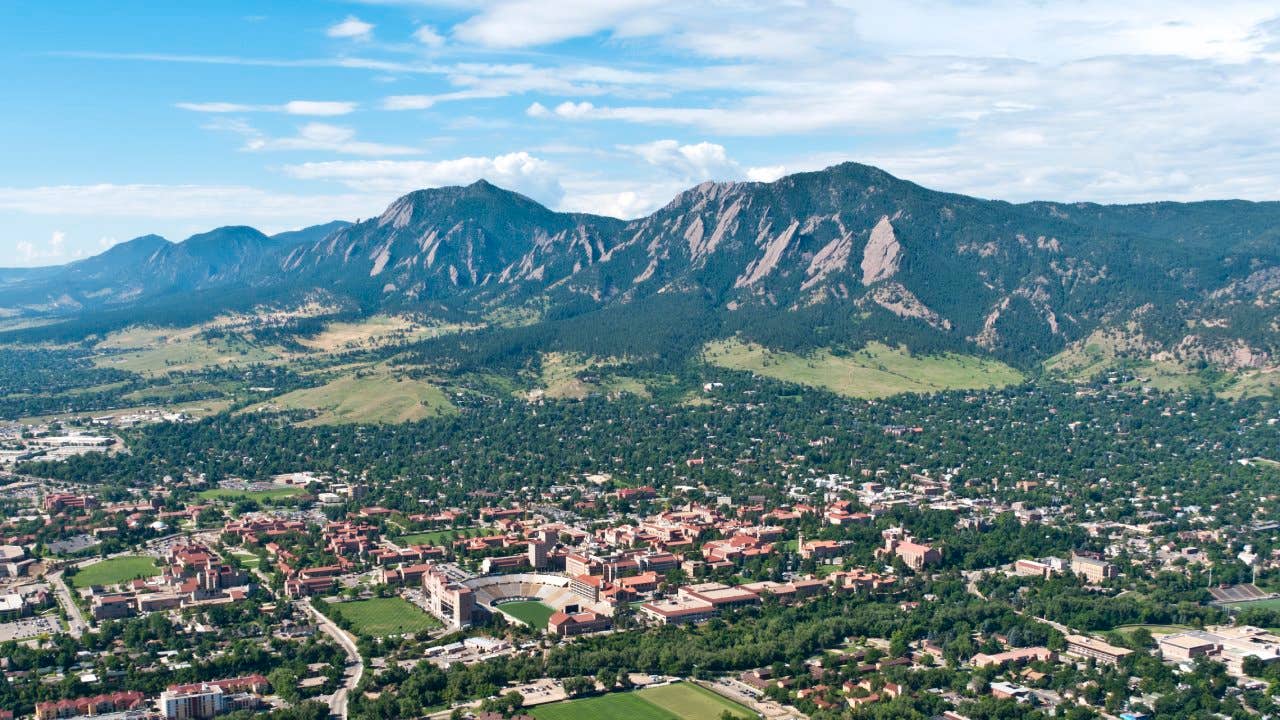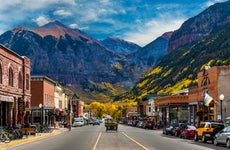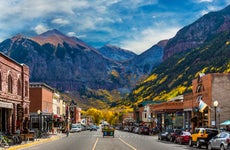Best places to live in Colorado in 2023

The Bankrate promise
At Bankrate we strive to help you make smarter financial decisions. While we adhere to strict , this post may contain references to products from our partners. Here's an explanation for .
Data points and related information in this article are maintained by an in-house natural language generation platform using industry-standard databases.
If you’re seeking a breathtakingly beautiful state with a high quality of life, Colorado is an excellent choice. Known for its diverse landscapes, from the Rocky Mountains to the Great Plains and the sprawling Colorado Plateau, Colorado offers an array of outdoor and urban adventures. Living here means plenty of fresh air; activities such as hiking, skiing and white-water rafting; and a strong, eco-conscious community. The state also has a robust economy with multiple industries, including technology, agriculture and tourism, which provide numerous employment opportunities.
You may think the Colorado housing market is all either ski chalets or Denver, but the state’s options to call home are as diverse as its landscape. Here are Bankrate’s top five places to live in Colorado, ranked based on factors including home prices, cost of living and average salary.
- Aurora
- Boulder
- Fort Collins
- Greeley
- Colorado Springs
1. Aurora
Our top pick is Aurora, a thriving suburban city just east of Denver with a diverse population and excellent outdoor recreational opportunities. Home to the University of Colorado’s Anschutz Medical Campus, Aurora has a strong health care industry and promises an excellent quality of life. With more than 100 parks in town, there’s no shortage of green space here, either. Sports enthusiasts will also appreciate Aurora’s proximity to the home stadiums of the Denver Broncos, Colorado Rockies and NBA champion Denver Nuggets.
- Median home-sale price: $461,226
- Cost of living: 105.0 (national average is 100)
- Average salary: $78,150
- Unemployment rate: 2.8%
- Total employees year over year: -0.1%
- Well-being: 70 out of 100
- Diversity: 57.4 out of 100
- Net migration: 0.2% population decrease year over year
Why it stands out: Aurora offers a relatively high average salary and the highest diversity score on our list at 57.4. Despite a slight population decrease, the city’s well-being score is a robust 70, offering excellent access to outdoor recreational opportunities and proximity to Denver.
2. Boulder
Nestled at the base of the Rocky Mountains, Boulder is home to the main campus of the University of Colorado. It’s a city known both for its commitment to environmentalism and for its array of tech companies and thriving startup scene, making it part of the greater Denver surrounding area nicknamed Silicon Mountain. Outdoor enthusiasts will appreciate Boulder’s 45,000 acres of open space, 300 miles of hiking and biking trails and proximity to excellent skiing, as well as the famously walkable Pearl Street Mall.
- Median home-sale price: $861,500
- Cost of living: 105.0 (national average is 100)
- Average salary: $89,593
- Unemployment rate: 2.5%
- Total employees year over year: +0.6%
- Well-being: 74 out of 100
- Diversity: 42.8 out of 100
- Net migration: 0.4% population decrease year over year
Why it stands out: With the highest well-being score and average salary on our list, Boulder offers both a high quality of life and strong economic opportunities to go along with all its natural beauty. However, it also has the highest median home price, reflecting its strong desirability.
3. Fort Collins
This vibrant college town, home to Colorado State University, is the northernmost city on our list. It offers a diverse economy and a rich cultural scene, all nestled in the foothills of the Rockies. With nearly 1,000 acres of parks, a historic downtown and good access to nearby mountain recreation, the city is perfect for outdoor enthusiasts. It’s also a destination for beer fans, with more than 20 craft breweries and a massive Anheuser-Busch facility.
- Median home-sale price: $565,000
- Cost of living: 105.0 (national average is 100)
- Average salary: $64,258
- Unemployment rate: 2.4%
- Total employees year over year: +2.4%
- Well-being: 64 out of 100
- Diversity: 35.4 out of 100
- Net migration: 0.7% population increase year over year
Why it stands out: Fort Collins is a thriving city with a growing population and the biggest increase in total employees on our list. Its low unemployment rate and ample opportunities for outdoor recreation offer a good balance between work and play.
4. Greeley
About an hour north of Denver, Greeley is a growing city with a strong agricultural heritage and a thriving economy. It offers a diverse range of industries, including oil and natural gas development. Education also plays a big role here, with the University of Northern Colorado and Aims Community College being major employers. Fun fact: The city is named after Horace Greeley, the famed 19th-century New York City newspaper editor who popularized the phrase “Go West, young man.”
- Median home-sale price: $410,000
- Cost of living: 105.0 (national average is 100)
- Average salary: $56,553
- Unemployment rate: 2.9%
- Total employees year over year: +0.5%
- Well-being: 58 out of 100
- Diversity: 49.3 out of 100
- Net migration: 2.0% population increase year over year
Why it stands out: Greeley boasts the highest net migration rate on our list, meaning more people are moving here than leaving. Its growing population combined with its relatively low median home-sale price — the most affordable on our list and less than half the price of a home in Boulder — make it an excellent option for those looking to enjoy the mountain lifestyle for less.
5. Colorado Springs
Located at the base of the majestic Pikes Peak, Colorado Springs offers residents a unique combination of stunning natural scenery and vibrant urban living. As the state’s second-largest city (behind Denver), it’s home to a diverse economy and a thriving arts and culture scene. Major employers include Lockheed Martin and the U.S. Air Force, whose sprawling military academy is located here. Colorado Springs is also often called Olympic City USA: It’s the home base of the U.S. Olympic & Paralympic Committee, with a training center that attracts 15,000 Team USA athletes every year.
- Median home-sale price: $463,000
- Cost of living: 105.0 (national average is 100)
- Average salary: $58,736
- Unemployment rate: 2.9%
- Total employees year over year: +1.4%
- Well-being: 60 out of 100
- Diversity: 51.8 out of 100
- Net migration: 0.4% population increase year over year
Why it stands out: Colorado Springs offers a fantastic mix of urban amenities, natural beauty and robust economic opportunities. It boasts a diverse and growing population, with strong total-employee growth as well.
Methodology
Choosing the best place to live is a very personal decision: It all depends on you and your individual circumstances. To help you decide, we’ve utilized data across five important categories to determine the Bankrate Best Places to Live lists: well-being, job markets, affordability, migration and diversity.
We sourced data from several trusted sources, including Sharecare, the U.S. Bureau of Labor Statistics, the Council for Community and Economic Research and the U.S. Census Bureau.
Below, find the formula that we utilized to calculate the weighted sum score for each city:
Weighted sum score = (Well-being * 0.30) + (Unemployment rate * -0.20) + (Total employees year-over-year * 0.05) + (Cost of living * -0.10) + (Average income * 0.05) + (Median home sale price * -0.05) + (Net migration * 0.15) + (Diversity * 0.10)
The data points in this story are up-to-date based on the following time frames:
- Median home-sale price: May 2023
- Cost of living: Q4 2022
- Average salary: 2021
- Unemployment rate: May 2023
- Total employees year over year: May 2023
- Well-being: 2021
- Diversity: 2020 Census
- Net migration: 2021
Some data points above are dynamic and update frequently. All were accurate at the time our data was pulled.
Other ranking considerations
- Includes cities with populations larger than 50,000, according to the U.S. Census Bureau’s “Annual Estimates of the Resident Population for Incorporated Places of 50,000 or More…”
- Includes only the top-scored city from each Metropolitan Statistical Area (MSA), which prevents one metro area from dominating the entire list.
- Includes cities that had data for at least 5 of our 8 metrics (as defined in “Data sources, metrics and definitions” above).
- In cases where a metric was missing, the city was assigned the state average for said metric. The most common missing data points were cost of living and median home price.
For more information about our data sources, what the individual data points mean, how they are weighted and more, visit the full Bankrate Best Places to Live Methodology.
Editor’s note: This article was updated to include the most recent data points at the time of publish.
Related Articles



